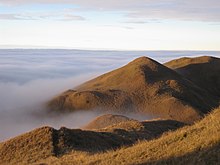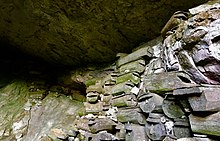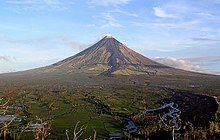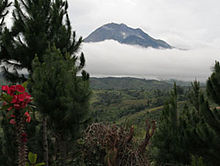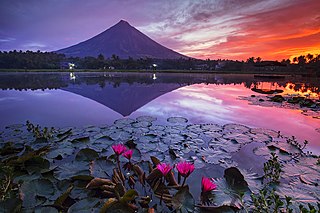
Albay, officially the Province of Albay, is a province in the Bicol Region of the Philippines, mostly on the southeastern part of the island of Luzon. Its capital is the city of Legazpi, the regional center of the whole Bicol Region, which is located in the southern foothill of Mayon Volcano.

The Bicol Region, commonly shortened to Bicol and designated as Region V, is an administrative region of the Philippines. Also referred to as Bicolandia, it comprises six provinces, four on the Bicol Peninsula : Albay, Camarines Norte, Camarines Sur, and Sorsogon, and two off the shore: Catanduanes and Masbate.

Camarines Sur, officially the Province of Camarines Sur, is a province in the Philippines located in the Bicol Region on Luzon. Its capital is Pili and the province borders Camarines Norte and Quezon to the northwest, and Albay to the south. To the east lies the island province of Catanduanes across the Maqueda Channel.

In the indigenous religion of the ancient Tagalogs, Bathalà/Maykapál was the transcendent Supreme God, the originator and ruler of the universe. He is commonly known and referred to in the modern era as Bathalà, a term or title which, in earlier times, also applied to lesser beings such as personal tutelary spirits, omen birds, comets, and other heavenly bodies which the early Tagalog people believed predicted events. It was after the arrival of the Spanish missionaries in the Philippines in the 16th century that Bathalà /Maykapál came to be identified with the Christian God, hence its synonymy with Diyós. Over the course of the 19th century, the term Bathala was totally replaced by Panginoón (Lord) and Diyós (God). It was no longer used until it was popularized again by Filipinos who learned from chronicles that the Tagalogs' indigenous God was called Bathalà.

The Tikbalang (/ˈtikbaˌlaŋ/) is a creature of Philippine folklore said to lurk in the mountains and rainforests of the Philippines. It is a tall, bony humanoid creature with the head and hooves of a horse and disproportionately long limbs, to the point that its knees reach above its head when it squats down. In some versions, it is a transformation of an aborted fetus sent to earth from limbo.

Philippine mythology is rooted in the many indigenous Philippine folk religions. Philippine mythology exhibits influence from Indonesian, Hindu, Muslim, Shinto, Buddhist, and Christian traditions.

A spirit house is a shrine to the protective spirit of a place that is found in the Southeast Asian countries of Burma, Cambodia, Laos, Thailand, Malaysia, Indonesia, Vietnam and the Philippines. They are normally in the form of small roofed structure mounted on a pillar or a dais, and can range in size from small platforms to houses large enough for people to enter. Spirit houses are intended to provide a shelter for spirits that could cause problems for the people if not appeased. They often include images or carved statues of people and animals. Votive offerings are left at them to propitiate the spirits; more elaborate installations include an altar for this purpose.

Filipino shamans, commonly known as babaylan, were shamans of the various ethnic groups of the pre-colonial Philippine islands. These shamans specialized in communicating, appeasing, or harnessing the spirits of the dead and the spirits of nature. They were almost always women or feminized men. They were believed to have spirit guides, by which they could contact and interact with the spirits and deities and the spirit world. Their primary role were as mediums during pag-anito séance rituals. There were also various subtypes of babaylan specializing in the arts of healing and herbalism, divination, and sorcery.
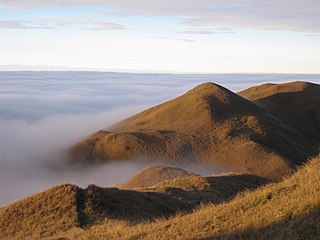
Indigenous Philippine folk religions are the distinct native religions of various ethnic groups in the Philippines, where most follow belief systems in line with animism. Generally, these indigenous folk religions are referred to as Anito or Anitism or the more modern and less ethnocentric Dayawism, where a set of local worship traditions are devoted to the anito or diwata, terms which translate to gods, spirits, and ancestors. 0.23% of the population of the Philippines are affiliated with the indigenous Philippine folk religions according to the 2020 national census, an increase from the previous 0.19% from the 2010 census.

The Waray people are a subgroup of the larger ethnolinguistic group Bisaya people, who constitute the 4th largest Filipino ethnolinguistic group in the Philippines. Their primary language is the Waray language, an Austronesian language native to the islands of Samar, Leyte and Biliran, which together comprise the Eastern Visayas Region of the Philippines. Waray people inhabit most of Samar where they are called Samareños/Samarnons, the northern part of the island of Leyte where they are called Leyteños, and the island of Biliran. In Leyte island, the Waray-speaking people are separated from the Cebuano-speaking Leyteños by the island's mountain range at the middle.

The Bakunawa is a serpent-like dragon in Philippine mythology. It is believed to be the cause of eclipses, earthquakes, rains, and wind. The movements of the Bakunawa served as a geomantic calendar system for ancient Filipinos and were part of the rituals of the babaylan priestess. It is usually depicted with a characteristic looped tail and a single horn on the nose. It was generally believed to be a sea serpent, but are also variously believed to inhabit either the sky or the underworld.

Bernardo Carpio is a legendary figure in Philippine mythology who is said to be the cause of earthquakes. There are numerous versions of this tale. Some versions say Bernardo Carpio is a giant, as supported by the enormous footsteps he has reputedly left behind in the mountains of Montalban. Others say he was the size of an ordinary man. Accounts of the stories have pre-colonial origins, but the name of the hero was Hispanized during the Spanish colonization. The original name of the hero has been lost in time. All versions of the story agree that Bernardo Carpio had a strength that was similar to that of many strong men-heroes in Asian epics, such as Lam-ang.

Souls in Filipino cultures abound and differ per ethnic group in the Philippines. The concept of souls include both the souls of the living and the souls or ghosts of the dead. The concepts of souls in the Philippines is a notable traditional understanding that traces its origin from the sacred indigenous Philippine folk religions.
Religions in pre-colonial Philippines included a variety of faiths, of which the dominant faiths were polytheist indigenous religions practiced by the more than one hundred distinct ethnic groups in the archipelago. Buddhism, Hinduism, and Islam were also present in some parts of the islands. Many of the traditions and belief systems from pre-colonial Filipino religions continue to be practiced today through the Indigenous Philippine folk religions, Folk Catholicism, and Folk Islam, among others.

The indigenous religious beliefs of the Tagalog people were well documented by Spanish missionaries, mostly in the form of epistolary accounts (relaciones) and entries in various dictionaries compiled by missionary friars.

Anito, also spelled anitu, refers to ancestor spirits, nature spirits, and deities in the indigenous Philippine folk religions from the precolonial age to the present, although the term itself may have other meanings and associations depending on the Filipino ethnic group. It can also refer to carved humanoid figures, the taotao, made of wood, stone, or ivory, that represent these spirits. Anito is also sometimes known as diwata in certain ethnic groups.
